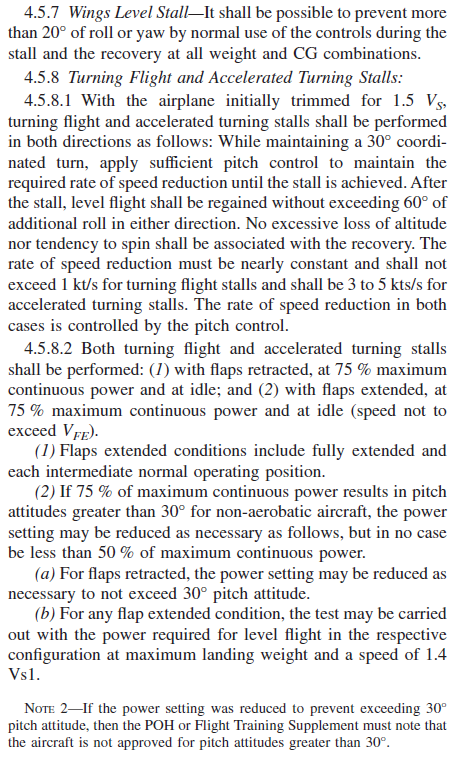Light plane flips at Moorabbin airport, trapping pilot
POH is as follows;
Balked Landing (Go around) 1. Throttle - full power (max.5800 rpm) 2. Wing flaps - extend as needed 3. Trim - adjust as needed 4. Wing flaps - retract at height of 150 ft after reaching 120 km/h (65 KIAS) 5. Trim - adjust 6. Repeat circuit pattern and landing
Balked Landing (Go around) 1. Throttle - full power (max.5800 rpm) 2. Wing flaps - extend as needed 3. Trim - adjust as needed 4. Wing flaps - retract at height of 150 ft after reaching 120 km/h (65 KIAS) 5. Trim - adjust 6. Repeat circuit pattern and landing
Not really, the requirement is for the test pilot to be able to prevent the wing drop exceeding specified amounts - that is test pilot, not just an instructor let alone a student pilot.
Is this at idle power? if not, how much power has to be used to meet certification requirements? Seems to me a grey area when it comes to LSA certification as against non LSA types.
David J Pilkington is online now Report Post
Quite a few configurations and flight states to consider, for example

Of course there was that error in the crew moment arms back then so the actual CG was further aft than determined by the POH.
Not a grey area at all as it seems to me that the requirements are quite clear.
Feel free.

Of course there was that error in the crew moment arms back then so the actual CG was further aft than determined by the POH.
David J Pilkington is online now Report Post
Seems a perculiarly written go-around procedure. Is that a manufacturer's POH or a flying school document? Extending flap in a go-around is most odd. Similarly all this advice about trimming doesn't sound like a manufacturer's language as trimming should be normal airmanship? Also use of 150 ft seems a bit dodgy when most height restrictions are in whole numbers e.g. 200 feet. As for "Repeat circuit pattern and landing" what a strange addition to a go-around
Got a good theory instructor (Kris K) who not only was a wealth of knowledge, but straightened me out to get my priorities right. Also finished at a time when the big glut of students passed, we all got along and were determined to finish. Also finished bang on my allotted hours, so wasnít forced to pay overs like a lot of students.
Join Date: May 2021
Location: Latrobe Valley
Posts: 1
Likes: 0
Received 0 Likes
on
0 Posts
Be interesting to see if these findings play a role in the class action.
What's the latest rumour in regards to the Class Action against BHI/Soar? everything's gone really quiet on that front, did the mediation in March go ahead?
What's the latest rumour in regards to the Class Action against BHI/Soar? everything's gone really quiet on that front, did the mediation in March go ahead?
Join Date: May 2021
Location: Tooradin
Posts: 7
Likes: 0
Received 0 Likes
on
0 Posts
Centaurus, I like everything you say. In my experience a go around from the flare or a bounce usually needs considerable forward stick force as power is applied and airspeed is regained. Quickly followed by adjustment of trim and flap. I doubt this is ever taught.
POH is as follows;
Balked Landing (Go around) 1. Throttle - full power (max.5800 rpm) 2. Wing flaps - extend as needed 3. Trim - adjust as needed 4. Wing flaps - retract at height of 150 ft after reaching 120 km/h (65 KIAS) 5. Trim - adjust 6. Repeat circuit pattern and landing
Balked Landing (Go around) 1. Throttle - full power (max.5800 rpm) 2. Wing flaps - extend as needed 3. Trim - adjust as needed 4. Wing flaps - retract at height of 150 ft after reaching 120 km/h (65 KIAS) 5. Trim - adjust 6. Repeat circuit pattern and landing
I once witnessed a student conduct 4 go-rounds during a first solo and then land perfectly, he just didn't feel happy with the first few attempts. I had a student on second solo once have crosswind increase slightly above his comfort level, so he went around, and requested the crossing runway to land. It might be assumed a pilot has airmanship, but if an aircraft has a sneaky bite to it, why not include it in the procedure. The wing flaps extend part is the more peculiar statement, but I don't know this type.
The additive "Repeat circuit pattern and landing" says to me, don't attempt to save the landing, just do another circuit. I was never a fan of teaching students to catch balloons/bounces and try to land extending landing distance and increasing the chances of mishaps. Go-round should be part of a solo check as much as each landing is.




